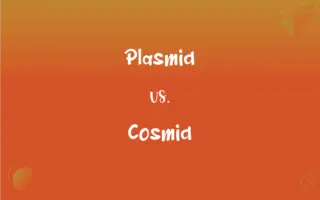Starch Cellulose vs. Glycogen: What's the Difference?
Edited by Aimie Carlson || By Janet White || Published on November 21, 2023
Starch and cellulose are polysaccharides in plants; starch stores energy, cellulose forms structural components. Glycogen, found in animals, is a storage form of glucose.

Key Differences
Starch and cellulose are both complex carbohydrates found in plants, but they serve different functions. Starch is a storage polysaccharide, primarily used by plants to store energy. It is digestible by humans and is a major source of energy in our diet. On the other hand, glycogen is the animal equivalent of starch and is the main storage form of glucose in the human body and other animals.
Cellulose, a component of starch cellulose, is a structural carbohydrate that forms the cell wall in plants, providing rigidity and strength. It is indigestible by humans due to its β-glycosidic bonds, which human digestive enzymes cannot break down. Glycogen, however, is structured to be easily accessible for quick energy release, making it crucial for energy metabolism in animals.
The molecular structure of starch involves α-glycosidic bonds, which allow it to be easily broken down by enzymes in the human digestive system. Cellulose, while also a polysaccharide like starch, has a different bond structure, making it resistant to digestion. Glycogen, similar to starch, has α-glycosidic bonds but is more extensively branched, allowing for rapid mobilization of glucose when needed by the body.
In terms of function, starch (including its cellulose component) in plants is analogous to glycogen in animals. While both starch (including cellulose) and glycogen serve as energy storage, cellulose also has the unique role of providing structural support in plants, a function not paralleled by glycogen in animals.
Starch, found in foods like potatoes and grains, is a major carbohydrate in the human diet, providing a slow and steady release of glucose into the bloodstream. Glycogen, stored in the liver and muscles, does not come directly from the diet but is synthesized by the body from glucose obtained from dietary carbohydrates.
ADVERTISEMENT
Comparison Chart
Location
Plants
Animals
Function
Energy storage (starch), structural support (cellulose)
Energy storage
Digestibility
Starch is digestible, cellulose is not
Digestible
Molecular Structure
α-glycosidic bonds (starch), β-glycosidic bonds (cellulose)
Highly branched with α-glycosidic bonds
Role in Diet
Dietary source of carbohydrates (starch)
Formed in the body, not consumed directly
ADVERTISEMENT
Starch Cellulose and Glycogen Definitions
Starch Cellulose
Starch is used by plants for energy storage.
Wheat stores energy as starch in its grains.
Glycogen
Main storage form of glucose in animals.
Glycogen stores provide energy during exercise.
Starch Cellulose
Indigestible component of plant cell walls (cellulose).
Cellulose gives vegetables their firm structure.
Glycogen
Not directly consumed in the diet, but formed from glucose.
After eating, excess glucose is converted into glycogen.
Starch Cellulose
Energy storage substance in plants (starch).
Potatoes are a good source of starch.
Glycogen
Key element in the body's energy metabolism.
Glycogen breakdown helps maintain blood sugar levels.
Starch Cellulose
Cellulose is a complex carbohydrate forming fibrous structures.
Cellulose is abundant in cotton.
Glycogen
Polysaccharide that is highly branched.
Glycogen's structure allows for rapid glucose release.
Starch Cellulose
Starch is a polysaccharide composed of glucose units.
Rice is high in starch content.
Glycogen
Synthesized and stored in the liver and muscles.
The liver can store large amounts of glycogen.
Glycogen
A polysaccharide, (C6H10O5)n, that is the main form of carbohydrate storage in animals and is found primarily in the liver and muscle tissue. It is readily converted to glucose as needed by the body to satisfy its energy needs. Also called animal starch.
Glycogen
(carbohydrate) A polysaccharide that is the main form of carbohydrate storage in animals; converted to glucose as needed.
Glycogen
A white, amorphous, tasteless substance resembling starch, soluble in water to an opalescent fluid. It is found abundantly in the liver of most animals, and in small quantity in other organs and tissues, particularly in the embryo. It is quickly changed into sugar when boiled with dilute sulphuric or hydrochloric acid, and also by the action of amylolytic ferments.
Glycogen
One form in which body fuel is stored; stored primarily in the liver and broken down into glucose when needed by the body
FAQs
Can humans digest cellulose?
No, humans can't digest cellulose due to its β-glycosidic bonds.
Is starch found in animal products?
No, starch is found in plant-based foods.
Is cellulose important for plant structure?
Yes, cellulose provides structural support in plants.
How is glycogen used by the body?
Glycogen is broken down to release glucose for energy.
Is starch used for energy?
Yes, starch is a primary energy source in many diets.
Are starch and cellulose the same?
No, they are different; starch is digestible, cellulose is not.
Does glycogen contribute to weight gain?
Excess glycogen can contribute to weight gain if not used for energy.
Where is glycogen stored in the body?
Glycogen is stored in the liver and muscles.
Does cellulose contribute to dietary fiber?
Yes, cellulose is a major component of dietary fiber.
How is starch different from glycogen in structure?
Starch has less branching compared to the highly branched structure of glycogen.
Can starch be converted into sugar in the body?
Yes, starch is broken down into glucose, a type of sugar, in the body.
What foods are high in starch?
Foods like potatoes, rice, and bread are high in starch.
Is glycogen a quick or slow source of energy?
Glycogen is a quick source of energy, readily converted to glucose.
Can glycogen be converted back to glucose?
Yes, glycogen can be converted back to glucose when needed.
What happens to glycogen during fasting?
Glycogen stores are broken down to maintain blood glucose levels during fasting.
Do humans have enzymes to digest starch?
Yes, humans have enzymes like amylase to digest starch.
Is cellulose used in non-food products?
Yes, cellulose is used in products like paper and textiles.
How long can glycogen stores last in the body?
Glycogen stores can last for about a day under normal conditions.
Is glycogen found in plants?
No, glycogen is not found in plants; it's an animal polysaccharide.
Does cooking affect starch in foods?
Cooking can make starch more digestible by breaking down its structure.
About Author
Written by
Janet WhiteJanet White has been an esteemed writer and blogger for Difference Wiki. Holding a Master's degree in Science and Medical Journalism from the prestigious Boston University, she has consistently demonstrated her expertise and passion for her field. When she's not immersed in her work, Janet relishes her time exercising, delving into a good book, and cherishing moments with friends and family.
Edited by
Aimie CarlsonAimie Carlson, holding a master's degree in English literature, is a fervent English language enthusiast. She lends her writing talents to Difference Wiki, a prominent website that specializes in comparisons, offering readers insightful analyses that both captivate and inform.






































































